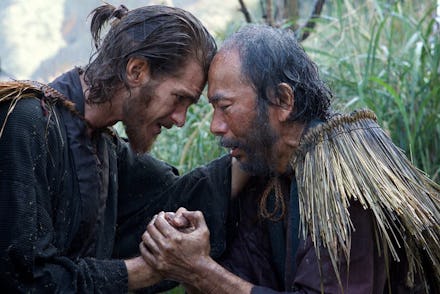'Silence' review: An in-depth look at Martin Scorsese's masterful religious epic

There's an overwhelming fear for the souls of those who apostatize and an even greater one for the faithful who were forced to renounce Christianity after the religion was outlawed in 17th-century Japan. This is the prevalent anxiety in Silence, Martin Scorsese's almost 30-year passion project (an adaptation of the 1966 Japanese novel by Shusaku Endo) a film as epic as Ben-Hur, as weighty as The Seventh Seal or the more recent Tree of Life — it's a masterful meditation on human suffering.
The opening image of Silence shows Japanese Christians hung to a cross, their bodies being scalded by boiling water. They can only save themselves from such torture; from death, by giving up their faith. This can be done by a symbolic gesture, stepping on a fumi-e, a slab depicting a religious image, and converting to Buddhism.
There's an element of absurdity to seeing this happen, especially when the stakes are life or death. But cinematographer Rodrigo Prieto shoots these scenes, repeated throughout Silence, to show the immense internal burden such an act creates: A shaking foot lingers over an image and finally, when the person decides to mark it with their step, they fall to the ground, break down in tears and are convinced they have just sold their ticket to salvation.
Such a threat sends Portuguese Jesuit priests Sebastião Rodrigues, played by Andrew Garfield, and Francisco Garrpe, played by Adam Driver, to Japan. They discover their mentor Father Cristóvão Ferreira, played by Liam Neeson, may have committed apostasy after being tortured by the Tokugawa shogunate, the anti-Christian ruling body of Japan in the 1600s, and in disbelief decide to seek him out. Silence follows their pilgrimage.
When the priests arrive to a coastal village in Japan, they are greeted by Christians, who practice their faith in secret. It's a complex, albeit profound image — to watch these villagers practice religion amid persecution. But it also brings to question if they would have been in this predicament if European missionaries hadn't converted them in the first place. Rodrigues and Garrpe are moved by their belief and strength, and are quick to assume what feels like prophetic roles in the village: blessing babies, overseeing burials, and hearing (and most of the time not understanding) many confessions. Scorsese presents these as montages, and there's an eerie sense of superiority and self-righteousness that emanates from the white men, narcissism even, as they become gods to these poor villagers.
Silence, at its bleakest, blames the missionaries for the violence. After the Japanese Inquisitor learns of their presence, he demands for the villagers to give the two men up, and when they refuse, he has three tied to wooden crosses by the coast, where they either die of starvation or exhaustion after the rising tide hits them over and over again. Rodrigues and Garrpe watch, traumatized. It's their first time they see, for their own eyes, the dangers of their arrival and, in a larger sense, their unwelcome belief system.
Silence grows to be even more complicated when showing the villagers' Christianity. Rodrigues — who ultimately splits up with Garrpe and undertakes the journey to find Father Ferreira on his own — sees his religion as distorted, most evident through the character of Kichijiro (Yôsuke Kubozuka), a Christian man who witnessed his entire family murdered for refusing to convert. He, on the other hand, did step on the fumi-e, did renounce Jesus, and throughout the film he follows Rodrigues, begging him to absolve him of his last sin so he can commit one anew. Silence portrays his religion as one of convenience, of weakness. It becomes easy to betray, to be weak in his resolve, when he can be forgiven so easily.
The latter half of the film is a test of faith for Rodrigues, who is captured by the Inquisitor and taken to the city of Nagasaki. It is there he learns the fate of Father Ferreira, witnesses the deaths of several more closeted Christians, and comes to understand the toxicity the Japanese rulers believes his religion to be in their land.
Garfield, the film's anchor, has a good-natured and innocent face, corrupted and confused by exposure to such brutality. It's a rich and dedicated performance, a career-best. As he is driven further into doubt, he questions the silence of his god, and it's here where the film truly grapples with the difficulty of belief in a violent world, a world perhaps first made violent by his belief.
But the true star of Silence is Scorsese. Silence is his most stunning picture, filmed to haunt and linger. It is minimal, quiet and determined. Several of his shots are hypnotic, meant to leave after-images: waves pounding against the bodies of dead Japanese men, a trail of blood staining the ground as a headless body is dragged away, white paper fans cooling the Inquisitor and his subjects. You lose yourself in Silence. But long after the film ends, his images stick, create an impression of incomprehensible warmth and love for all of us who believe, who don't believe, who suffer and wonder why.
Mic has ongoing movie review coverage. Please follow our main movie review hub.